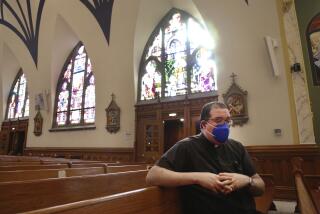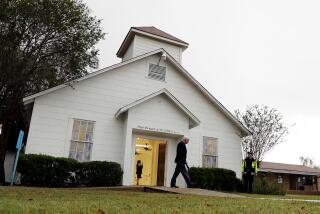Number of Attendees Disputed in Study : Sociology: Scholars say Gallup polls and other surveys have greatly inflated the rate of church attendance. One sociologist calls the report flawed.
- Share via
A high-level debate, spiced with a dash of bare-knuckle language, has erupted in some academic circles over claims by three scholars that the rate of church attendance in the United States, as established by decades of telephone polls, has been heavily inflated.
The study, based partly on head counts of churchgoers, argues that the rate of church attendance is about half that claimed for years by social scientists and publicized by historians and journalists.
If the revised rate proves true, it would have significant implications for assumptions about American religious practice that have long undergirded articles in popular and academic journals.
The harshest attack of the new study came from Catholic priest-sociologist Father Andrew Greeley, who called it “a sloppy piece of work.”
“I doubt, if the subject was anything but religion, that a serious social science journal would publish it,” said Greeley, who teaches sociology of religion at the University of Chicago.
George Gallup Jr., chairman of the Gallup International Institute in Princeton, N.J., declined any comment on the study, saying he wanted to evaluate it further and confirm his own data.
Greeley’s objection aside, the work was presented--and by several accounts, well received--last month at the American Sociological Assn.’s annual meeting. It will be published in the December issue of American Sociological Review.
Gerald Marwell, editor of the review, said he was not surprised by the reaction from Greeley and his colleague, Michael Hout, professor of sociology at UC Berkeley and director of the Survey Research Center. Hout also panned the study in an interview. Greeley and Hout, whose own phone surveys on the subject have resulted in numbers similar to Gallup’s, are cited in the current work.
“To some extent he (Greeley) was one of the people who is argued against in the research . . . so I am not altogether surprised” by his comments, Marwell said. He noted that the article, following the usual practice for all submissions to the journal, was reviewed before publication by a panel of sociologists.
The study, titled “What the Polls Don’t Show: A Closer Look at U.S. Church Attendance,” is the work of three researchers: Dr. Kirk Hadaway, a sociologist working for the United Church Board for Homeland Ministries; Dr. Penny Long Marler, professor of religion at Samford University in Birmingham, Ala., and Dr. Mark Chaves, assistant professor of sociology at the University of Notre Dame in South Bend, Ind.
The study reports that about 20% of Protestants and 28% of Catholics attend church in any given week, figures that are dramatically lower than results of a 1992 Gallup poll. Gallup reported church attendance at 45% of Protestants and 51% of Catholics.
For decades, similarly high Gallup poll figures have gone unquestioned, consistently showing weekly church attendance to be more than 40% for all denominations.
The researchers say their results call into question the validity of the kind of telephone polling on which the Gallup figures are based. “When people self-report in a survey, they tend to over-report what they perceive to be socially desirable behavior,” Chaves said.
At the same time, the authors of the new study invite others to check their work. “We have shown that the church attendance rate probably is half what everyone thinks it is. But the practical difficulties involved with this research place limits on the exhaustiveness of our data collection efforts. . . . Research in other areas of the United States is called for to test this conclusion.”
The research is based, in part, on an elaborate counting of Protestant churches and congregants attending those churches in rural Ashtabula County in northeastern Ohio. That count turned out to be considerably lower than the number of people in the county who, in a telephone poll taken about the same time as the head count, said they attended church.
The Catholic research was aided by annual head counts conducted in a number of dioceses across the country during the four weekends of October. Comparisons of the head counts to figures obtained from self-reporting showed a wide discrepancy.
“To generalize from a county in Ohio to all of Protestant America is irresponsible,” Greeley said.
“Careful social research--and I think this was careful research--does not demand that they do all the counties in America,” or even a large sample, Marwell said. “I think they’ve made a real contribution to opening this question for America as a whole.”
He added: “And I think that one of the major roles of good scholarship of this kind is to question what economists call ‘stylized facts’ that people in the newspaper industry and others pass around as if they were the truth.”
Marwell said it becomes “incumbent on other” researchers to demonstrate how the county in this study is out of line with the rest of the country.
Hout said everyone who has worked with the Gallup figures “recognized some inflation. But I find the claims of an inflation factor being two to be excessive.”
Hout said he had problems with the way the head counts were conducted and with “naive use” of the Gallup figures by the media.
How Many Churchgoers?
Here is a comparison of recent polls on the percentage of Christians who attend church in any given week. The Gallup poll relied on self-reporting of attendance. The “Closer Look” poll is based on a study of church attendance in a rural county in Ohio, and on head counts made by a number of Catholic dioceses across the country.
Protestants Catholics 1992 Gallup Poll 45% 51% “Closer Look” Poll 20% 28%
More to Read
Sign up for Essential California
The most important California stories and recommendations in your inbox every morning.
You may occasionally receive promotional content from the Los Angeles Times.













